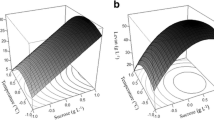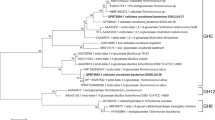Abstract
Levan-type fructooligosaccharides (L-FOSs) are a prominent class of non-digestible oligosaccharides with potential as nutritional prebiotics. Endo-levanase, which randomly hydrolyzes β-(2,6)-linkages in fructans, is a promising enzyme for short-chain FOS production. In this work, a recombinant levanase (LevBk) from Bacillus koreensis strain HL12 was characterized. Soluble LevBk protein was produced in Escherichia coli BL21(DE3) system at 40 mg/L of culture medium. Based on sequence and structural analysis, LevBk was classified as a member of endo-levanase in GH32 family containing N-terminal substrate binding pocket and C-terminal β-sandwich domains. LevBk optimally worked at 45 °C, pH 6.0 with the specific activity of 2.43 U/mg. Based on enzymatic hydrolysis, short-chain L-FOSs with degree of polymerization (DP) of 2–4 were produced from hydrolysis of timothy grass levan under optimal conditions for 9–24 h. With its ability to produce L-FOSs with specific chain lengths, LevBk could be attractively applied for converting of levan containing material to high value-added sweetener in the biorefinery industry.






Similar content being viewed by others
Data Availability
The datasets generated during and/or analyzed during the current study are available from the corresponding author on reasonable request.
References
Mardo K, Visnapuu T, Vija H, Aasamets A, Viigand K, Alamae T (2017) A highly active endo-levanase BT1760 of a dominant mammalian gut commensal Bacteroides thetaiotaomicron cleaves not only various bacterial levans, but also levan of Timothy Grass. PLoS ONE 12:e0169989
Adamberg K, Tomson K, Talve T, Pudova K, Puurand M, Visnapuu T, Alamäe T, Adamberg S (2015) Levan enhances associated growth of Bacteroides, Escherichia, Streptococcus and Faecalibacterium in fecal microbiota. PLoS ONE 10:e0144042
Hamdy AA, Elattal NA, Amin MA, Ali AE, Mansour NM, Awad GEA, Farrag ARH, Esawy MA (2018) In vivo assessment of possible probiotic properties of Bacillus subtilis and prebiotic properties of levan. Biocatal Agric Biotechnol 13:190–197
Ayuso M, Michiels J, Wuyts S, Yan H, Degroote J, Lebeer S, Le Bourgot C, Apper E, Majdeddin M, Van Noten N, Vanden Hole C, Van Cruchten S, Van Poucke M, Peelman L, Van Ginneken C (2020) Short-chain fructo-oligosaccharides supplementation to suckling piglets: assessment of pre- and post-weaning performance and gut health. PLoS ONE 15:e0233910
Shim SB, Williams IH, Verstegen MWA (2005) Effects of dietary fructo-oligosaccharide on villous height and disaccharidase activity of the small intestine, pH, VFA and ammonia concentrations in the large intestine of weaned pigs. Acta Agric Scand A 55:91–97
Hernot DC, Boileau TW, Bauer LL, Middelbos IS, Murphy MR, Swanson KS, Fahey GC (2009) In vitro fermentation profiles, gas production rates, and microbiota modulation as affected by certain fructans, galactooligosaccharides, and polydextrose. J Agric Food Chem 57(4):1354–1361
Marx SP, Winkler S, Hartmeier W (2000) Metabolization of β-(2,6)-linked fructose-oligosaccharides by different bifidobacteria. FEMS Microbiol Lett 182:163–169
Porras-Domínguez JR, Ávila-Fernández Á, Rodríguez-Alegría ME, Miranda-Molina A, Escalante A, González-Cervantes R, Olvera C, López Munguía A (2014) Levan-type FOS production using a Bacillus licheniformis endolevanase. Process Biochem 49(5):783–790
Jensen SL, Diemer MB, Lundmark M, Larsen FH, Blennow A, Mogensen HK, Nielsen TH (2016) Levanase from Bacillus subtilis hydrolyses β-2,6 fructosyl bonds in bacterial levans and in grass fructans. Int J Biol Macromol 85:514–521
Jung Kang E, Lee SO, Lee JD, Lee TH (1999) Purification and characterization of a levanbiose-producing levanase from Pseudomonas sp. No. 43. Biotechnol Appl Biochem 29:263–268
Park J, Kim M-I, Park Y-D, Shin I, Cha J, Kim CH, Rhee S (2012) Structural and functional basis for substrate specificity and catalysis of levan fructotransferase. J Biol Chem 287(37):31233–31241
Soon Lim Y, Kyung Kang S, Ok Lee S, Dong Lee J, Tae Ho L (1998) Purification and characterization of a levanase from Streptomyces sp. 366L. J Biotechnol 61:33–41
Hövels M, Kosciow K, Deppenmeier U (2021) Characterization of a novel endo-levanase from Azotobacter chroococcum DSM 2286 and its application for the production of prebiotic fructooligosaccharides. Carbohydr Polym 255:117384
Dahech I, Ayed HB, Belghith KS, Belghith H, Mejdoub H (2013) Microbial production of levanase for specific hydrolysis of levan. Int J Biol Macromol 60:128–133
Käll L, Krogh A, Sonnhammer EL (2004) A combined transmembrane topology and signal peptide prediction method. J Mol Biol 338:1027–1036
Tamura K, Stecher G, Kumar S (2021) MEGA11: molecular evolutionary genetics analysis version 11. Mol Biol Evol 38:3022–3027
Robert X, Gouet P (2014) Deciphering key features in protein structures with the new ENDscript server. Nucleic Acids Res 42:W320–W324
Thompson JD, Higgins DG, Gibson TJ (1994) CLUSTAL W: improving the sensitivity of progressive multiple sequence alignment through sequence weighting, position-specific gap penalties and weight matrix choice. Nucleic Acids Res 22:4673–4680
Miller GL (1959) Use of dinitrosalicylic acid reagent for determination of reducing sugar. Anal Chem 31:426–428
Shi Q, Hou Y, Xu Y, Mørkeberg Krogh KBR, Tenkanen M (2019) Enzymatic analysis of levan produced by lactic acid bacteria in fermented doughs. Carbohydr Polym 208:285–293
Jabeen A, Mohamedali A, Ranganathan S (2019) Protocol for protein structure modelling. In: Ranganathan S (ed) Encyclopedia of bioinformatics and computational biology. Academic Press, Oxford, p 252–272
Goddard TD, Huang CC, Meng EC, Pettersen EF, Couch GS, Morris JH, Ferrin TE (2018) UCSF ChimeraX: meeting modern challenges in visualization and analysis. Protein Sci 27:14–25
Pettersen EF, Goddard TD, Huang CC, Meng EC, Couch GS, Croll TI, Morris JH, Ferrin TE (2021) UCSF ChimeraX: structure visualization for researchers, educators, and developers. Protein Sci 30:70–82
Meng EC, Pettersen EF, Couch GS, Huang CC, Ferrin TE (2006) Tools for integrated sequence-structure analysis with UCSF Chimera. BMC Bioinform 7:339
Willard L, Ranjan A, Zhang H, Monzavi H, Boyko RF, Sykes BD, Wishart DS (2003) VADAR: a web server for quantitative evaluation of protein structure quality. Nucleic Acids Res 31:3316–3319
Williams CJ, Headd JJ, Moriarty NW, Prisant MG, Videau LL, Deis LN, Verma V, Keedy DA, Hintze BJ, Chen VB, Jain S, Lewis SM, Arendall WB 3rd, Snoeyink J, Adams PD, Lovell SC, Richardson JS, Richardson DC (2018) MolProbity: more and better reference data for improved all-atom structure validation. Protein Sci 27:293–315
Schrödinger L, DeLano W (2020) PyMOL. Available from http://www.pymol.org/pymol
Zhang W, Xu W, Ni D, Dai Q, Guang C, Zhang T, Mu W (2019) An overview of levan-degrading enzyme from microbes. Appl Microbiol Biotechnol 103:7891–7902
Jumper J, Evans R, Pritzel A, Green T, Figurnov M, Ronneberger O, Tunyasuvunakool K, Bates R, Žídek A, Potapenko A, Bridgland A, Meyer C, Kohl SAA, Ballard AJ, Cowie A, Romera-Paredes B, Nikolov S, Jain R, Adler J, Back T, Petersen S, Reiman D, Clancy E, Zielinski M, Steinegger M, Pacholska M, Berghammer T, Bodenstein S, Silver D, Vinyals O, Senior AW, Kavukcuoglu K, Kohli P, Hassabis D (2021) Highly accurate protein structure prediction with AlphaFold. Nature 596:583–589
Kufareva I, Abagyan R (2012) Methods of protein structure comparison. Methods Mol Biol (Clifton, N.J.) 857:231–257
Abd Rahman NH, Jaafar NR, Abdul Murad AM, Abu Bakar FD, Shamsul Annuar NA, Md Illias R (2020) Novel cross-linked enzyme aggregates of levanase from Bacillus lehensis G1 for short-chain fructooligosaccharides synthesis: developmental, physicochemical, kinetic and thermodynamic properties. Int J Biol Macromol 159:577–589
Li Y, Triccas JA, Ferenci T (1997) A novel levansucrase-levanase gene cluster in Bacillus stearothermophilus ATCC12980. Biochim Biophys Acta 1353:203–8
Mendez-Lorenzo L, Porras-Dominguez JR, Raga-Carbajal E, Olvera C, Rodriguez-Alegria ME, Carrillo-Nava E, Costas M, Lopez Munguia A (2015) Intrinsic levanase activity of Bacillus subtilis 168 levansucrase (SacB). PLoS ONE 10:e0143394
Hiery E, Poetsch A, Moosbauer T, Amin B, Hofmann J, Burkovski A (2015) A proteomic study of Clavibacter michiganensis subsp. michiganensis culture supernatants. Proteomes 3:411–423
Miasnikov AN (1997) Characterization of a novel endo-levanase and its gene from Bacillus sp. L7. FEMS Microbiol Lett 154:23–28
Trizna E, Bogachev M, Kayumov A (2019) Degrading of the Pseudomonas aeruginosa biofilm by extracellular levanase SacC from Bacillus subtilis. BioNanoScience 9:1–5
Igarashi T, Takahashi M, Yamamoto A, Etoh Y, Takamori K (1988) Purification and characterization of Levanase from Actinomyces viscosus ATCC 19246. Infect Immun 55:3001–5
Murakami H, Kuramoto T, Mizutani K, Nakano H, Kitahata S (1992) Purification and some properties of a new levanase from Bacillus sp. No. 71. Biosci Biotechnol Biochem 56:608–13
Ernits K, Eek P, Lukk T, Visnapuu T, Alamae T (2019) First crystal structure of an endo-levanase—the BT1760 from a human gut commensal Bacteroides thetaiotaomicron. Sci Rep 9:8443
Maaroufi H, Levesque RC (2015) Glycoside hydrolase family 32 is present in Bacillus subtilis phages. Virol J 12:157
Hövels M, Kosciow K, Kniewel J, Jakob F, Deppenmeier U (2020) High yield production of levan-type fructans by Gluconobacter japonicus LMG 1417. Int J Biol Macromol 164:295–303
Tanaka K, Yamaguchi F, Kusui S (1989) Action of levan fructotransferase of Arthrobacter ureafaciens on levan and phlein. Agric Biol Chem 53:1203–1211
Kang SK, Lee SO, Lim YS, Jang KL, Lee TH (1998) Purification and characterization of a novel levanoctaose-producing levanase from Pseudomonas strain K-52. Biotechnol Appl Biochem 27:159–166
Sonnenburg ED, Zheng H, Joglekar P, Higginbottom SK, Firbank SJ, Bolam DN, Sonnenburg JL (2010) Specificity of polysaccharide use in intestinal bacteroides species determines diet-induced microbiota alterations. Cell 141:1241–1252
Menendez C, Hernandez L, Selman G, Mendoza MF, Hevia P, Sotolongo M, Arrieta JG (2002) Molecular cloning and expression in Escherichia coli of an exo-levanase gene from the endophytic bacterium Gluconacetobacter diazotrophicus SRT4. Curr Microbiol 45:5–12
Kasperowicz A, Pristas P, Piknová M, Javorský P, Guczyńska W, Michałovski T, Kwiatkowska E (2010) Fructanolytic and saccharolytic enzymes of Treponema zioleckii strain kT. Anaerobe 16:387–92
Chaudhary A, Gupta LK, Gupta JK, Banerjee UC (1996) Purification and properties of levanase from Rhodotorula sp. J Biotechnol 46:55–61
Acknowledgements
The authors gratefully acknowledge the financial support by Faculty of Science and Technology, Thammasat University, Contract No SciGR 9/2564. The authors acknowledge the support provided by Enzyme Technology Research Team, National Center for Genetic Engineering and Biotechnology and Department of Biotechnology, Faculty of Science and Technology, Thammasat University. The authors would like to thank Dr. Nattapol Arunrattanamook for manuscript proofreading and comments.
Author information
Authors and Affiliations
Contributions
HL, BB and VC conceived and designed the work. HL, BB, TK, RW and PJ performed the experiments, and analyzed the data. HL, BB, PJ and RW drafted the manuscript. BB and VC critically revised the manuscript for intellectual content. All authors have read and agree to the submission of the manuscript.
Corresponding author
Ethics declarations
Conflict of interest
The authors declare that they have no conflicts of interest with the contents of this article.
Additional information
Publisher's Note
Springer Nature remains neutral with regard to jurisdictional claims in published maps and institutional affiliations.
Supplementary Information
Below is the link to the electronic supplementary material.
Rights and permissions
Springer Nature or its licensor holds exclusive rights to this article under a publishing agreement with the author(s) or other rightsholder(s); author self-archiving of the accepted manuscript version of this article is solely governed by the terms of such publishing agreement and applicable law.
About this article
Cite this article
Lekakarn, H., Bunterngsook, B., Jaikaew, P. et al. Functional Characterization of Recombinant Endo-Levanase (LevBk) from Bacillus koreensis HL12 on Short-Chain Levan-Type Fructooligosaccharides Production. Protein J 41, 477–488 (2022). https://doi.org/10.1007/s10930-022-10069-2
Accepted:
Published:
Issue Date:
DOI: https://doi.org/10.1007/s10930-022-10069-2




